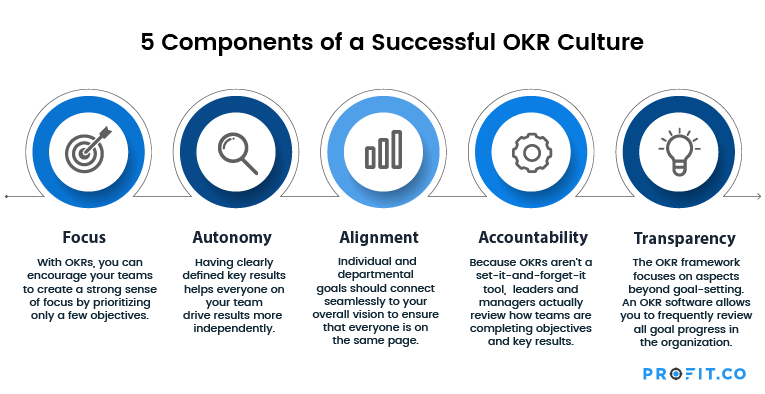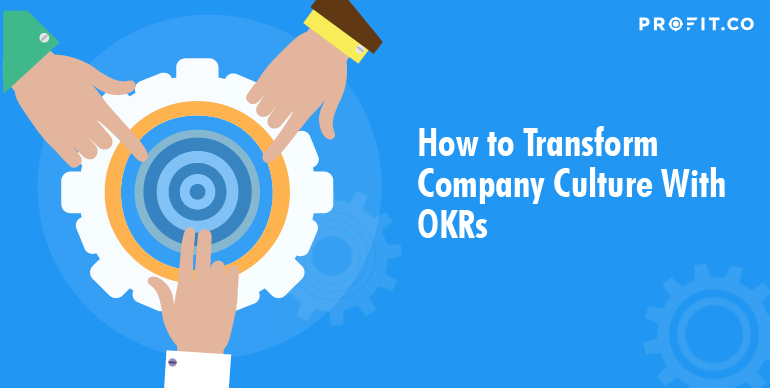The Relationship Between OKRs and Company Culture
OKRs help you set, manage, and achieve goals through collaboration and feedback. As a result, this fosters a transparent and cohesive work environment. When everyone is on the same page, your team is more likely to feel like they have a role to play and that they’re a part of something important. This is key to building a positive company culture.Here’s how OKRs can help you establish an efficient and transparent work culture:
- Set clear, long-term goals
When teams know exactly what they need to do, it not only boosts their chances of getting it done, but it also helps align their daily work with company-level priorities, ensuring that everyone is working towards the same goals. Ensure that all contributors know how to write great OKRs for best results. - Hold weekly check-ins and updates
Regularly meeting with employees allows you to review goal progression. This is when you provide feedback on how they’re performing and determine if they’re on track to complete their goals. This transparency allows team members to grow. Plus, having leaders who care about their progress makes employees feel like an important contributor in the company, fostering better engagement and productivity. - Give credit and recognition
If a team member is doing well, managers can recognize their accomplishments. Encouraging words and even rewards can go a long way in making employees feel appreciated. This, in turn, boosts employee satisfaction. Happier employees make for a more positive workplace, and high employee morale and engagement translates directly to higher productivity.
Foundations of a Successful OKR Culture

Below are key aspects of a strong company culture guided by the OKR methodology:
- Focus: With OKRs, you can encourage your teams to create a strong sense of focus by prioritizing only a few objectives. As a result, everyone knows their role and how they need to perform within that role.
- Autonomy: Having clearly defined key results helps everyone on your team become more independent in improving their work performance and driving results. That’s because they know exactly what they need to do, how to do it, and when they need to complete it.
- Alignment: When you create OKRs, you’re creating them in context with your organizational goals. That means individual and departmental goals should connect seamlessly to your overall vision. This cascading approach to goal-setting ensures everyone is on the same page when it comes to moving the business forward.
- Accountability: Because OKRs aren’t a set-it-and-forget-it tool, leaders and managers actually review how teams are completing objectives and key results. This often involves one-on-one meetings that evaluate progress and discuss ways for employees to improve their performance and methods for driving results.
- Transparency: The OKR framework focuses on aspects beyond goal-setting. When managed on an OKR software, you can view OKRs for the entire organization and get a pulse check on any contributor’s top targets. This culture of transparency is what creates a more unified organization, and helps leaders catch issues early.
Building a High-Performance Company Culture with OKRs
Follow these best practices to transform company culture with OKRs.Conduct Regular Reviews
The problem with traditional goal-setting models is that they don’t prioritize accountability, and instead, just “set and forget” goals. If you take this approach when using OKRs, you will not achieve your targets. Without proper check-ins and accountability, teams can easily fall out of alignment with company priorities, and individual contributors can veer off track and make avoidable OKR mistakes. Meet regularly with team members to review their performance alongside their OKRs and understand any challenges they have in achieving objectives. You can hold company-wide reviews, one-on-one meetings, or both. The method you choose to meet with key players isn’t what is most important. What matters is that you’re conducting a review to gauge their performance. During these meetings, you can provide honest feedback on how each contributor is doing. Whether they’re exceeding expectations or are missing the mark when it comes to completing objectives, discussing their accomplishments or failures is key to a transparent and high-growth culture.Ask Employees Feedback Questions
A manager’s insights are paramount to a team member’s success in carrying out OKRs. But what about the team member’s feedback? Understanding their thoughts and concerns is key to uncovering where they may have gone wrong with their strategy. But employee feedback shouldn’t just be limited to failures. It can also reveal what methods have contributed to their success in completing their goals. So, asking feedback questions can not only help team members improve performance, it can foster a transparent company culture that’s open and honest.Below are some examples of questions you can ask key players:
- Is your OKR on track to be completed by the end of the quarter? If not, why? And what do you plan to do about it?
- What’s the main thing in the way of meeting your key objectives this quarter?
- How can I help with one of your work goals to keep team objectives on track?
Examples of OKRs to Set for People Operations and Professional Development
Below are some examples of OKRs you can set for team building and culture:OKR Examples for People Ops
 Objective
Objective
Create a people-first company culture
Target Date: Q1-2022
Jan 01 – Mar 31
Visibility: All Employees
 Key Results
Key Results
Train 100% of managers on best practices for creating positive company culture
Celebrate 1 small win and any type of progress every single week
Improve perks to increase engagement score by 30%

 Objective
Objective
Create a diverse and inclusive team
Target Date: Q1-2022
Jan 01 – Mar 31
Visibility: All Employees
 Key Results
Key Results
Increase women in leadership positions from 20% to 30%
Get 100% of hiring managers, interviewers, and recruits to attend unconscious bias workshop
Rewrite 100% of job descriptions to include inclusive language

OKR Examples for Learning and Development
 Objective
Objective
Enable professional growth for everyone.
Target Date: Q1-2022
Jan 01 – Mar 31
Visibility: All Employees
 Key Results
Key Results
Roll out a mentorship/coaching program to at least 80% of employees
Ensure the 10 incoming interns complete an internship development course
Achieve 100% development course completion rate for frontline employees

 Objective
Objective
Improve the effectiveness of our training program
Target Date: Q1-2022
Jan 01 – Mar 31
Visibility: All Employees
 Key Results
Key Results
Decrease the time to complete the course from 30 to 14 days
Improve the average training score from 70% to 85%
Improve training satisfaction rates by 30%




